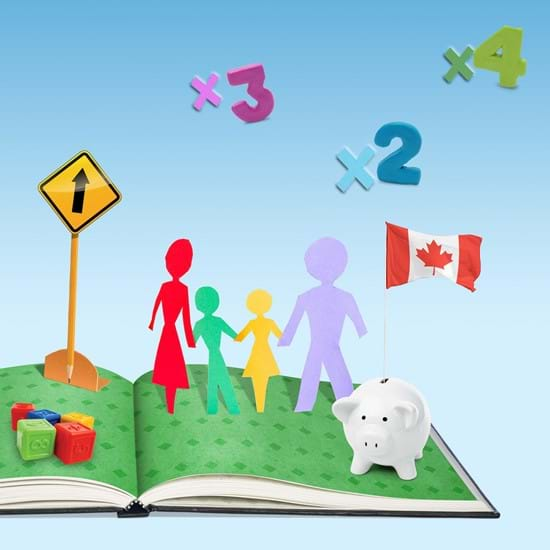
Inflation and Education Savings: What’s the Right Strategy?
The sharp upswing in the cost of living due to inflation is currently hurting every family in Quebec. Shrinking purchasing power is forcing families to make difficult compromises in their consumption habits, which is also affecting their saving priorities and investments. To adjust your education savings strategy to the current economic and financial situation, it is worth taking the time to understand the impact of inflation.
Understanding inflation
The Bank of Canada defines inflation as a persistent rise in the average level of prices over time.1 The steady increase in prices we are currently seeing is eroding consumers’ purchasing power in every area. The Consumer Price Index (CPI) measures the change in prices by comparing the costs of goods and services and then determines the rate of inflation. In June 2022, year—over—year inflation in Canada reached 8.1%, the highest level in 30 years, according to Statistics Canada data.2
For the past few months, families in Quebec have been feeling the effects of inflation in very real ways. The soaring costs of food, gasoline, housing and many other goods and services have generated a great deal of discussion and media coverage. Obviously, students and their parents are not untouched by the situation—far from it!
Students are being hit hard
Rising prices are affecting many areas of the economy, including education costs. Stéphane Corriveau, President of AlphaFixe Capital, explains that, according to the latest CPI figures, education prices and tuition fees in Quebec have increased by 3.0% and 3.6%, respectively over the past year, which is much higher than the 2.1% and 2.2% increases observed between 2016 and 2019.
“The general rise in wages during this period of inflation and labour shortages partly explains the higher education costs,” says Ms. Corriveau. In addition to higher tuition fees, students also have to pay more for transportation and food. Students who have to move away from the family home to pursue their studies also have to deal with rising rents. “Since December 2020, the rent price index in Quebec has gone up 5.8%,” explains François Galarneau, senior economist at AlphaFixe Capital.
Young adults who are post-secondary students and whose parents contributed to an education savings plan (RESP) have a significant advantage. This financial assistance is even more crucial in the current environment of ongoing widespread price increases.
Understanding how inflation affects your investment returns
Beyond its current impact on the cost of living, inflation also causes turbulence in the financial markets, which affects the returns on your investment portfolios.
As Mr. Galarneau explains, “the fact that inflation has persisted for more than a year means that central banks will have to intervene by raising key rates aggressively and quickly, at the risk of causing a recession next year.”
For fixed-yield investments such as bonds, inflation erodes the purchasing power of the interest income, thereby reducing their value. Bonds with short maturities are more affected than bonds with longer maturities.
In the stock markets, a significant increase in input costs generally reduces companies’ profit margins and consequently their share value. In addition, companies with high debt loads have to pay more interest on their loans, which cuts into their future profits.
The extent of any recession will depend on the decisions of central banks and their interest rate policies. If central banks keep key rates high for a long time, the recession could lead to a significant downturn in employment and gross domestic product (GDP).
Mr. Galarneau believes that the next few quarters will be a difficult time for the financial markets. Your investment returns may be affected in the short term.
What’s the best approach for education savings?
According to our experts at AlphaFixe Capital, regardless of the economic and financial environment, RESPs remain a superior investment vehicle because of the government grants that come with them.
To support your savings efforts, the Government of Canada and the Government of Quebec top up your contributions by depositing money directly into your RESP. Depending on your adjusted family net income and the amount of your contributions, you could receive up to $12,800 per child ($9,200 in New Brunswick).3
Over time, your savings and the money invested by the governments will grow tax-free—a double bonus!
Key points
In a high-inflation environment, it’s best to stay focused on your investment strategy and your long-term goals while leveraging the savings and benefits of an RESP to prepare for your children’s post-secondary education. Taking a disciplined approach to making contributions allows you to maximize your grants, which is a good way to cope with the impact of inflation on your children’s future education expenses and counteract market volatility.
Kaleido can help you build an education savings strategy that meets your needs. Start planning for your children’s future with an RESP today by making an appointment with one of our representatives.

Find out in seconds how much an RESP could earn you with the free calculator.
1. Source: “Understanding inflation”.
2. Source: “Consumer Price Index, June 2022”.
3. Canada Education Savings Grant (CESG) of 20% to 40% and Québec Education Savings Incentive (QESI) of 10% to 20%, based on adjusted family net income. The maximum annual CESG payment is $600, and the maximum annual QESI payment is $300. The maximum lifetime CESG and QESI payments per beneficiary are $7,200 and $3,600, respectively. Canada Learning Bond (CLB) of up to $2,000 per beneficiary for a child born after December 31, 2003, whose family is financially eligible. Some conditions apply. Check out our prospectus at kaleido.ca.



